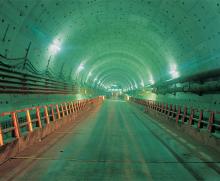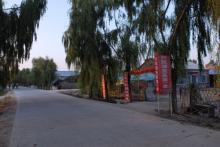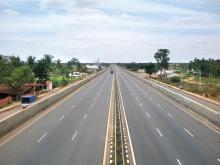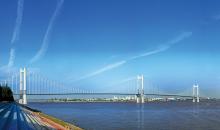
Construction in China still appears to be on course for growth even with the gloomy economic outlook, as it enjoys "a strong budgets position." Patrick Smith reports
One thing is certain in the current global economic climate: nothing is certain. And while China has not been unaffected by the economic events of recent months it has, according to Robert Zoellinck, president of theFor some years, the nation has enjoyed double digit growth (the world's fastest), and while any forecasts about its future (as with most countries at present) may have to be revised, it has successfully staged the Olympic Games at a cost of some US$20 billion and seen its first man walk in space as envisaged in its 11th Five-Year Guidelines (2006-2010), the country has had set backs and Sichuan Province is still trying to get back to a semblance of normality after the devastating earthquake that struck on 12 May, killing thousands of people.
In a recent exclusive interview with the official Xinhua News Agency, Justin Lin, chief economist and senior vice president for Development Economics at the World Bank, told the agency that China should stimulate the domestic demand to cope with the current financial crisis.
Lin, who is the first chief economist of World Bank from a developing country, said China's stable and fast economic development is itself one of the contributions to the world economy.
He is quoted by Xinhua: "The stable and rapid economic development in China not only boosts China's export, but also provides a bigger market for the rest of the world." However, economists have cut forecasts for growth with the
Meanwhile, another expert said that to sustain China's economic expansion, the country requires an efficient highway network, and despite the challenges and risks involved, there are still many opportunities for financially viable and environmentally sustainable road development in China.
Indeed, in the Five-Year Plan the government announced plans for 14 new expressways over the period including one from Beijing to Hong Kong and Macao. Another focus in the national highway system is on rural roads with China hoping to complete at least 5,000km of expressways this year (making a total length of about 60,000km), meaning that 21 provinces, municipalities and regions now have freeway networks longer than 1,000km. China plans to expand its highway network to 85,000km of expressways by 2020.
However, the government is intent on boosting the western part of the country and its vast rural inland regions, and is investing more money on building roads to link more remote villages to each other and ease travel for rural farmers with an estimated 270,000km being built or upgraded this year.
According to the China Daily, 423,000km of rural roads were built or upgraded last year, with rural roads reaching 88% of all administrative villages and 98.5%. China currently has 3.57 million km of roads and a 35,000km National Highway System (five north-south trunk roads and seven east-west trunk roads), that "took shape at the end of last year", 13 years ahead of the original plan.
And it is understood that by 2020 that some 97 new airports will be constructed to cater for soaring demand (air traffic volumes rose by 16% to 185 million in 2007), meaning that eight out of every ten residents will live within 100km of an airport within 12 years.
All this gives added weight to recent forecasts, which say that construction spending in China is expected to increase 9.2%/year in real terms through to 2012. A rapidly expanding domestic economy, continuing efforts to upgrade physical infrastructure, sustained strength in foreign investment funding, healthy demand for Chinese manufactured goods, ongoing urbanisation, and further population and household growth will all boost construction spending in China.
These trends are presented in Construction Outlook in China, a new study from The
Non-building construction will be the fastest growing sector, advancing 10.2% annually in real terms through to 2012 with growth fuelled by government initiatives to expand and upgrade the country's physical infrastructure, especially its highways, railways and subway systems. Utilities construction will also contribute to non-building construction spending gains, as the government continues to increase the country's power generation capacity and improve electricity transmission networks, as well as expand and improve municipal water supply coverage and natural gas distribution.
According to Messe München International (MMI, Munich Trade Fairs International Group), which is organising the
(25-28 November in Shanghai), the construction machinery sectors in China and all of eastern Asia are still experiencing double digit growth rates.
"As the boom in the construction industry continues, these countries with the largest populations in the world have excellent prospects for the future," says the company (www.bauma-china.com).
Worldwide latent demand for construction machinery remains at a high level and is expected to grow by 16% by 2012. Asia is the largest market, with US$63.5 million in volume (35.1%), followed by Europe with $46.7 million (25.8%) and North America and the Caribbean with $42 million (23.2%).
In Asia, more than 75% of the overall market is divided between China (36%), Japan (23%) and India (17%), followed by South Korea and Indonesia (another 10% combined).
According to Chinese statistics, in 2006 around 50% of the worldwide consumption of cement was accounted for by the People's Republic, as well as 30%t of total iron consumption and 15% of total energy consumption.
However, by 2010 the aim is for energy consumption to decrease by 20% and emissions of dangerous greenhouse gases by 10%.
"This ambition presents the international exhibitors with the same challenges on Asian markets as they are facing on European and American markets. Namely, that in terms of both product innovation and optimisation, what is needed are new techniques and a reorientation on the part of both manufacturers and users. Automated processes, for example, increase the quality of aerated concrete and sand-lime bricks, avoiding wastage in the production process. Expensive soil replacement, too, can be avoided through the use of new machinery, attachments and building materials, with the result that emissions are reduced because less material needs to be transported away from the site," says MMI.
High-tech equipment was used to prepare for the marathon race during the Olympic Games, when runners made history in front of Beijing's historic Forbidden City and Tiananmen Square, on a road made smooth by a
Contractor Beijing Fujinfeng Henglong was selected to handle the work for this high-profile paving project along Chang'An Street, arguably the most famous and certainly one of the busiest roads in Beijing. For this reason, the Chinese government wanted work completed as quickly as possible without sacrificing quality.
Jim McReynolds, president of Caterpillar Global Paving said: "Over the last several decades, Caterpillar machines and engines have been involved in building Olympic venues all around the world, and I am certainly pleased that our customers in China again used Caterpillar products for the work leading up to the 2008 Games." The Cat PM-200 is a product that has only recently been introduced to paving contractors in China, and Caterpillar says "the machine's speed, power and reliability are already winning over customers such as Beijing Fujinfeng Henglong Road Maintenance." Based on the success of its first Cat PM-200, Zhang bought two more Cat PM-200s for use on projects around Beijing.
Indeed, during the seven-year organisation period for the Olympic Games, construction work has involved hundreds of companies. For example,
Case says its machinery was also involved in maintenance and security work at the Olympic facilities, and local dealer Beijing HAWK doubled the level of parts inventory to ensure no delays in parts availability and delivery.
From the mid-2007 to mid-2008, the Beijing section of the Beijing-Tianjin-Tangshan Highway (the main expressway to Beijing) was widened by adding a 3m lane in each direction.
In another development, work on the second stretch of the Beijing-Tianjin Highway has been completed and offers a high-class link between the country's second largest urban area and its third (see separate story).
Development plans for the island of Chongming at the mouth of the Yangtze River (it covers 20% of Shanghai's land area) have been improved with the breakthrough of two 7.4km tunnels. Excavated using the world's biggest tunnel boring machines, the tunnels connect Shanghai with Changxiang and a bridge connects Changxiang and Chongming (see Tunnel Construction/Services this issue).
Meanwhile,
Citilog's automatic incident detection (AID) system is used to monitor traffic on the bridge and on the south and north links that lead to the bridge. Processing the CCTV videos of the fixed cameras along the bridge, the MediaRoad system is providing real-time alarms for stopped vehicles, pedestrians and debris.
"Our selection by the Hangzhou Bay Bridge operator to use Citilog's MediaRoad product for this world's largest sea-crossing bridge is continued testament of our ability to meet the largest traffic management needs of any operator around the world," said Christian Girardeau, CEO of Citilog.
Opened to traffic on 2 May, 2008, the new bridge means that the previous trip from Ningbo to Shanghai and southern Jiangsu Province, involving a detour of around 400km is reduced to 80km. It is seen as a critical infrastructure within the highway network of the 'Golden Triangle' (Shanghai, Hangzhou and Ningbo), which is considered as one of the hottest economy zones in China. The area of the Yangtze River delta contributes 21% of the national gross and has 8% of the total population in China.
Earlier this year
The contract, which forms part of a prestigious World Bank project, consists of the provision of a new Urban Traffic Control (UTC) system with PC SCOOT and the supply and installation of more than 400 ST800 signal controllers and 1,000 detector units throughout the year and into 2009.
According to Peter Gorton, Siemens' general sales manager, Wuhan is positioning itself as one of the most progressive cities in Asia. The Hubei province is situated in the heart of China and is building infrastructure for the future, to deal with its growing population and increased levels of road and pedestrian traffic.
"Supporting this continued development, and working in association with our colleagues at Siemens Limited China, our equipment will help the city manage the additional traffic more effectively," he said.
CONEXPO Asia 2009
The next
Organisers, the
CONEXPO Asia 2007 more than doubled in size compared to the inaugural show, held in 2006, in terms of exhibit space and number of attendees. The 2007 show had 28,000 visitors from 115 countries, compared to the 2006 event's 13,000 attendees from 75 countries. About 20% of attendance was international, and show organisers expect to significantly increase that number for the 2009 CONEXPO Asia.
"We will build upon the success of the previous CONEXPO Asia events to bring the best of the region and the world direct to the China and Asia-Pacific marketplace," noted Petra Kaiser, CONEXPO Asia show manager. "With the improved facility, we can continue to expand the opportunities for industry knowledge-sharing in a convenient and first-class location for the worldwide marketplace." Guangzhou is located in the important Pearl River Delta region in southern China, near Hong Kong.
Major new link opened
The second stretch of the Beijing-Tianjin Highway, the second main artery between Beijing and Tianjin, opened to traffic before the Olympic Games. The highway was first constructed in 1993 and was the only highway from Beijing to Tianjin. As the largest city on China's northern coast, Tianjin's urban area is the third largest in China, ranked only after Shanghai and Beijing and the road is also an important link to the port city of Tanggu, 30km south of Tianjin.
When originally built, traffic volumes were estimated at 50,000 vehicles/day. However current rush hour traffic can reach congestion rates of 120,000 vehicles/day with an average 70,000-80,000 vehicles/day so capacity is insufficient and congestion is a problem.
The highway has been repaired many times in recent years due to widespread pavement damage. As the road quality diminished and congestion increased, the number of traffic accidents grew and to local residents, the highway became known as the Road of Death.
To solve the traffic problem between Beijing and Tianjin, a plan was devised to construct a new highway. The new Beijing-Tianjin-Tangshan Expressway Number 2 Highway, known as the North Pass, is a bidirectional, eight-lane highway.
Built in two segments, from the Fifth Ring Road, close to Xizhi River of Chaoyang District, Beijing Municipality, and ending at Beitang Town of Tanggu, Tianjin Municipality, the road is 178km long and has speed limits ranging from 80-120km/hour.
At the Beijing section of the highway, the contractor paved three asphalt surfaces using four
Jiao Wanli was project manager of the Second Company of Beijing Luqiao Construction Group managing the construction of this 17km segment of road called Bidding I. He said specifications for the structure of the asphalt road surface of the main road called for a top surface layer paved with 50mm stone matrix asphalt (SMA16), a middle surface layer with 60mm modified asphalt concrete (AC-20), and the bottom surface layer of 90mm asphalt concrete (ATP-25).
Work on a third highway between Beijing and, known as the Third Pass, is scheduled to begin soon.











